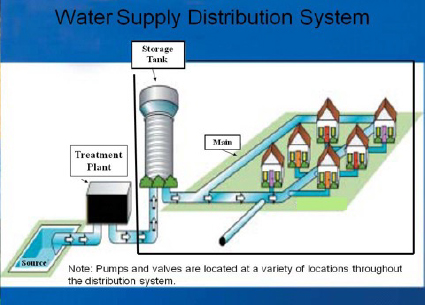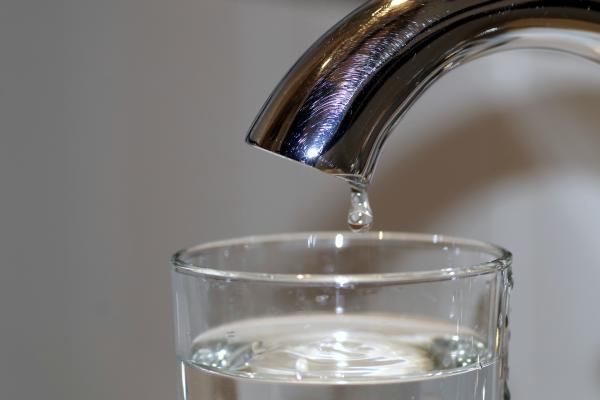Approximately 90% of the U.S. population relies on drinking water from a public water system, with the remainder (about 13 million households) drinking water from private wells. There are approximately 150,000 public water systems in the U.S. today, defined by the EPA as “systems providing water for human consumption through pipes or other constructed conveyances for at least 15 service connections or serves an average of at  least five people for at least 60 days a year”. Most public water systems (61%) use surface water (lakes, streams, rivers), while 39% use groundwater (wells) as their source.
least five people for at least 60 days a year”. Most public water systems (61%) use surface water (lakes, streams, rivers), while 39% use groundwater (wells) as their source.
Surprisingly, a public water system may be publicly or privately owned
93% of Americans using public water systems obtain their water from medium, large, or very large public water systems, with the remaining 7% getting water from very small or small systems.
 Most of the problems with drinking water occur in very small and small water systems and private wells.
Most of the problems with drinking water occur in very small and small water systems and private wells.
What is Regulated?
The EPA sets regulations, under the Safe Drinking Water Act (SDWA), for all public water systems, consisting of standards for 90 contaminants in drinking water:
- Microorganisms (total and fecal coliform) and pathogens like Giardia, Cryptosporidium that cause stomach problems and can result in serious illness
- Inorganic (arsenic, lead, cadmium, and others) and organic (pesticides, volatile and synthetic organic) chemicals
- Radionuclides (radium-226 and 22, alpha/photon emitters, beta photon emitters, uranium)
- By-products of disinfection (chemicals produced after chlorine, or other chemicals disinfectants react with organic matter in the water, creating new chemicals)
“Systems serving less than 500 people accounted for nearly 70 percent of all violations (violations of sampling requirements, reporting rules, and exceeding drinking water standards) and a little over half of all health-based violations (exceeding drinking water standards only).” Natural Resources Defense Council
Most medium to very large water systems have largely done a good job meeting the EPA drinking water regulations. However, the same cannot be said for very small to small systems. (The EPA does not regulate private wells) In general, large systems have greater financial, administrative, and technical capacity than small systems. Small systems may be unable or unwilling to increase water rates to their small subscriber base to cover needed capital improvements. In addition, if there are violations of drinking water standards, small systems may not have the technical capabilities to correct the underlying problems.
“Radioactive material and pesticides among new contaminants found in U.S. tap water”
The source of this report, a drinking water database by the Environmental Working Group (EWG). The article says that regulators have identified 56 new contaminants in drinking water, with many causing dangerous health problems such as cancer, reproductive disruption, and liver disease
I queried the database for my zip code in Raleigh, North Carolina, where I found that my drinking water supply exceeded the EWG health guidelines for 12 contaminants! However, further reading informed me that my drinking water complied with all federal-based drinking water standards.
How is this possible?
Because the EWG has written its own drinking water standards, according to the EWG, “Legal does not = Safe; EWG Health Guidelines fill the gap in outdated government standards.”
- The EWG wrote their own in those cases where the EPA did not have a standard for a contaminant.
- The EWG wrote their own standards for several contaminants already regulated by the EPA, with most about a 100-fold lower than EPA’s standard. For example, the EPA standard for a group of disinfection by-products (trihalomethanes) is 80 parts per billion (ppb); the EWG’s 0.15 ppb. Total trihalomethanes were detected at 28.3 ppb in my drinking water supply, so it complied with EPA’s regulations but exceeded the EWG’s. Anyone can make a standard look bad by writing a lower one.
- There is no scientific rationale for the EWG’s lower health guidelines. EPA’s regulations are set at very low levels, using very conservative methods that include large safety factors to ensure they are protective of all population members.
- The EWG ignored that some of EPA’s regulations are written for groups of chemicals instead of individual ones. For example, their assertion that the EPA does not have a standard for chromium (hexavalent) is false; the EPA regulates total chromium, including hexavalent and trivalent chromium. The EWG failed to recognize the group regulations for 9 out of the 12 contaminants in my drinking water supply.
The assertion that “regulators have identified 56 new contaminants in drinking water” is absurd. These are not new contaminants; the EPA identified them under regulations requiring water utilities to monitor them in drinking water. The EPA uses the water utilities' information to determine whether there is sufficient occurrence nationally to begin the rulemaking process.
We are finding these chemicals in drinking water because we now can measure chemicals down to the parts-per-trillion (ppt) level instead of the parts-per-million (ppm) level just 20 years ago. It is not that these chemicals were not present 20 years ago; it is just that we couldn’t measure them. As analytical methods continue to improve, the number of chemicals detected will continue to increase.
What about lead?
Lead is a different issue than most other drinking water contaminants. As I have written, the lead found in drinking water is almost always the result of lead pipes that were allowed in U.S. drinking water supplies until the 1980s. The lead in the pipes can react with the water passing through them (corrosion), resulting in higher levels of lead in water in homes than found in the water treatment plants.
The EPA regulates lead by its Lead and Copper Rule that requires water utilities to test for lead at the treatment plant and treat their water with chemical coatings that prevent corrosion of the pipes.
In Flint, Michigan, the water was not treated for corrosion control. The city had neglected to add one chemical, phosphate, that prevents lead from leaching into the water. According to an expert in environmental engineering, “The entire Flint water crisis could have been avoided if the city had just added orthophosphate.”
The Flint episode was not due to lack of Federal regulations; it was due to human error or negligence in following the regulations. The only sure way to limit lead exposure from drinking water is to remove lead pipes and service lines – the current Infrastructure Bill contains $15 billion to remove lead pipes, a good start to making lead pipes an issue of the past.
Practical advice
You may have reasons to question your water quality, but there are simple steps to reassure yourself that your drinking water is safe.
If you get water from a private well, it’s critical that you do the following:
- Get your water tested annually for the largest number of contaminants possible. Contact your local health department (many will test it for free); if not, get recommendations for state-certified private laboratories. The results should say if any contaminants exceed the EPA drinking water regulations. If not, contact your local health department to determine their significance.
- If needed, investigate on-site treatments, such as disinfection and filtration to remove contaminants found in the water.
If you get water from a public water system of any size:
- Read your Consumer Confidence Report or Drinking Water Quality Report that is required to be sent annually with your water bill. (Some large systems may have the reports online.) The report outlines test results for regulated contaminants for the past year and reports any violations of EPA drinking water standards. It also tells if any detections were found for contaminants on EPA’s Unregulated Contaminant Monitoring Regulation list.
- Pay particular attention to this report if you get water from a very small or small water system. In this case, size matters.
- Remember, all violations are not equal. A non-health-related violation involving monitoring requirements is not necessarily worrisome. For a health-related violation, check to see the reported levels – slightly over the standard is probably not of concern, while one greatly exceeding the standard may warrant action.
- If there is a contaminant from EPA’s Unregulated Contaminant Monitoring Regulation, check the EPA for a Health Advisory to determine if the level found in your water is below the Health Advisory recommendation.
- If you have general questions or are unsure, call EPA’s Safe Drinking Water Hotline at 800-426-4791.
If you do find worrisome levels of contaminants, a water filter may be your best option. However, these can be very expensive and do not work for all contaminants. Do research using an unbiased source, like Consumer Reports, before investing in one. Unless you have been alerted by your health department or know your private well has been contaminated, bottled water may be no safer than tap water. Many consumers have needlessly wasted large sums of money using bottled water instead of water from the tap.




